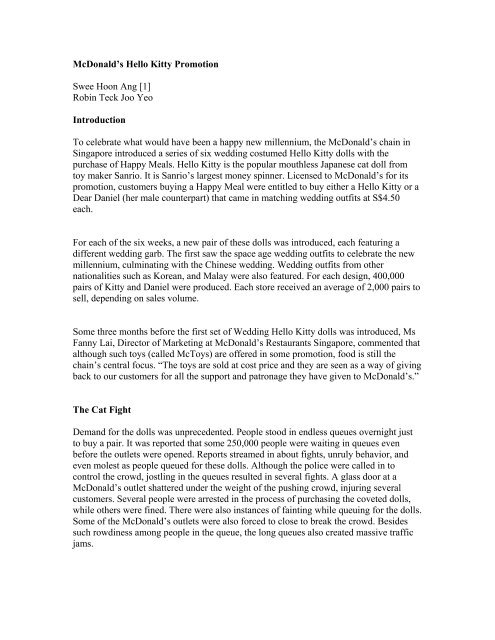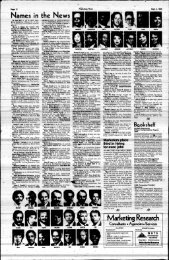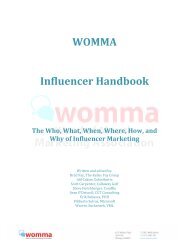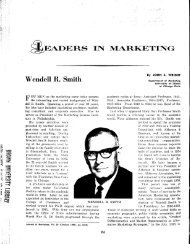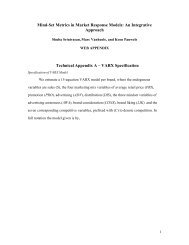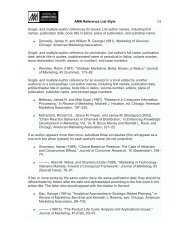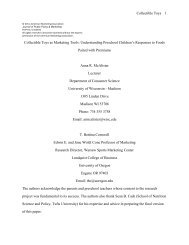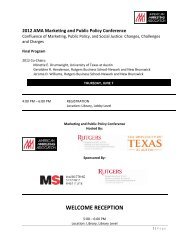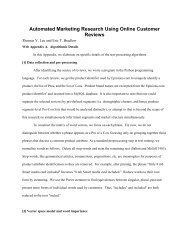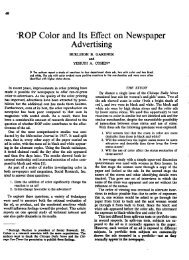McDonald's Hello Kitty Promotion - American Marketing Association
McDonald's Hello Kitty Promotion - American Marketing Association
McDonald's Hello Kitty Promotion - American Marketing Association
Create successful ePaper yourself
Turn your PDF publications into a flip-book with our unique Google optimized e-Paper software.
McDonald’s <strong>Hello</strong> <strong>Kitty</strong> <strong>Promotion</strong><br />
Swee Hoon Ang [1]<br />
Robin Teck Joo Yeo<br />
Introduction<br />
To celebrate what would have been a happy new millennium, the McDonald’s chain in<br />
Singapore introduced a series of six wedding costumed <strong>Hello</strong> <strong>Kitty</strong> dolls with the<br />
purchase of Happy Meals. <strong>Hello</strong> <strong>Kitty</strong> is the popular mouthless Japanese cat doll from<br />
toy maker Sanrio. It is Sanrio’s largest money spinner. Licensed to McDonald’s for its<br />
promotion, customers buying a Happy Meal were entitled to buy either a <strong>Hello</strong> <strong>Kitty</strong> or a<br />
Dear Daniel (her male counterpart) that came in matching wedding outfits at S$4.50<br />
each.<br />
For each of the six weeks, a new pair of these dolls was introduced, each featuring a<br />
different wedding garb. The first saw the space age wedding outfits to celebrate the new<br />
millennium, culminating with the Chinese wedding. Wedding outfits from other<br />
nationalities such as Korean, and Malay were also featured. For each design, 400,000<br />
pairs of <strong>Kitty</strong> and Daniel were produced. Each store received an average of 2,000 pairs to<br />
sell, depending on sales volume.<br />
Some three months before the first set of Wedding <strong>Hello</strong> <strong>Kitty</strong> dolls was introduced, Ms<br />
Fanny Lai, Director of <strong>Marketing</strong> at McDonald’s Restaurants Singapore, commented that<br />
although such toys (called McToys) are offered in some promotion, food is still the<br />
chain’s central focus. “The toys are sold at cost price and they are seen as a way of giving<br />
back to our customers for all the support and patronage they have given to McDonald’s.”<br />
The Cat Fight<br />
Demand for the dolls was unprecedented. People stood in endless queues overnight just<br />
to buy a pair. It was reported that some 250,000 people were waiting in queues even<br />
before the outlets were opened. Reports streamed in about fights, unruly behavior, and<br />
even molest as people queued for these dolls. Although the police were called in to<br />
control the crowd, jostling in the queues resulted in several fights. A glass door at a<br />
McDonald’s outlet shattered under the weight of the pushing crowd, injuring several<br />
customers. Several people were arrested in the process of purchasing the coveted dolls,<br />
while others were fined. There were also instances of fainting while queuing for the dolls.<br />
Some of the McDonald’s outlets were also forced to close to break the crowd. Besides<br />
such rowdiness among people in the queue, the long queues also created massive traffic<br />
jams.
Besides such physical unruliness, there were also some civic embarrassments.<br />
Singaporeans were more interested in the dolls than in the Extra Value Meals. Thousands<br />
of the hamburgers were strewn on the roads. People were not interested in eating them.<br />
They queued only for the dolls and threw away the meal set that had to be bought to buy<br />
the doll. The mindless throwing away of food fit for eating enraged the community.<br />
After the first five wedding sets were introduced in the first month, McDonald’s had<br />
raked in S$20 million from the meal-and-kitty set. A total of 2.8 million dolls were sold,<br />
and 12,000 meals were donated to charities by customers who were more interested in the<br />
dolls than in the meals.<br />
Here, There, Everywhere<br />
Such frenzy, however, was not confined only to Singapore, but also to other countries as<br />
well. The Taiwanese population likewise created a frenzy for these lovable dolls when<br />
McDonald’s held a similar promotion. In just two weeks, the Taiwan press reported<br />
fights caused at McDonald’s. One McDonald’s outlet in a museum closed temporarily<br />
because of the chaos.<br />
Business Week reported that some 1,000 people waited to get into a McDonald’s in an<br />
upscale Hong Kong mall. The hook – a chance to buy <strong>Hello</strong> <strong>Kitty</strong>. People who were<br />
paying $2.32 for a <strong>Hello</strong> <strong>Kitty</strong> with a minimum food purchase of $1.95 did not mind<br />
seeing a big return on their investment as similar <strong>Hello</strong> Kitties go for $15 in local<br />
department stores. McDonald’s says the promotion has boosted sales 10% at its 158<br />
outlets – quite a feat in recession-ravaged Hong Kong, where the economy shrank by 5%<br />
the previous year.<br />
However, such unruly acts did not occur in Malaysia where the outlets in City Square and<br />
Plaza Pelangi in Johor Bahru beefed up their securities by installing railings to guide the<br />
queue. Instead, the Malaysian fans were more interested in finding out the reason behind<br />
the craze in their neighboring country for <strong>Hello</strong> <strong>Kitty</strong> and Dear Daniel. Student Ronald<br />
Wong, a 22 year-old Malaysian said that he had heard much about the <strong>Kitty</strong> craze in<br />
Singapore and had thus come to see for himself what it was all about. The frenzy was<br />
almost non-existent in Malaysia.<br />
Inside a Collector’s Mind<br />
In the 10 years that McDonald’s Singapore introduced toys accompanying its Happy<br />
Meals, 20 million of such meals have been sold. These include 875 different types of<br />
McDonald’s toys (or McToys) and they have sold over 34 million pieces. One such series<br />
of toys was the Sesame Street Mini Bean Pals. To collect all 24 toys in this series, a
consumer would have to fork out some S$180 for the cost of the meals, toys, and carrier;<br />
and consume 22,200 calories. Over 2.5 million pieces were sold. In another promotion<br />
involving Winnie the Pooh and Friends, a million pieces at S$3.50 each were sold within<br />
10 days. Such fanaticism over McToys is not restricted to Singapore only. Below are<br />
some examples of what length consumers will go to get these toys:<br />
· In Singapore, second-hand Winnie the Pooh toys were sold and bought for as much<br />
as S$35 each, 10 times more than the retail price.<br />
· In Taiwan, a McToy fanatic threatened McDonald’s staff at knife-point when the<br />
store ran out of <strong>Hello</strong> <strong>Kitty</strong> toys.<br />
· Some Taiwanese customers who failed to get hold of <strong>Hello</strong> <strong>Kitty</strong> plushes after<br />
queuing for hours suffered nervous breakdowns.<br />
· In Hong Kong, a security guard was sentenced for stealing 21 McDonald’s Snoopy<br />
figurines from office desks.<br />
For the Wedding Millennium pair, a customer was offered $100 right after she bought<br />
them.<br />
Ms Lai revealed that McDonald’s usually conduct a consumer research survey before it<br />
selects the toy to promote. Toys are picked according to their collectibility, playability,<br />
and value for money. According to a sociologist, by selling these toys as a series rather<br />
than just individually, the toys become more desirable because each toy contributes<br />
towards something (the series) greater than the sum of its parts (individually). Indeed, the<br />
partnership between McDonald’s and Disney allowing the former to sell Disney toys with<br />
its meals has benefited the chain. When the alliance was first implemented, McDonald’s<br />
reported a 7% increase in sales.<br />
Why are people crazy over these dolls or toys that accompany the fast food? An 11-year<br />
old girl said, “I collect McDonald’s toys because they are cute. But I don’t collect all of<br />
them. I only buy those I like.” Another, an adult, said he has to eat at McDonald’s two or<br />
three times a day on some days to get the entire series. He feels that these plush toys are<br />
worth buying because “you can’t find these plush toys in other shops.”<br />
However, several feel that such fanaticism is irrational. Says a parent, “Collecting these<br />
toys is a pure waste of time and money. Kids will just play with them for a while and then<br />
they’ll just throw them away. If children buy computer games, they can at least play with<br />
them again and again.” Another, with a more balanced view, said, “It’s a waste of money<br />
because most of the time, the toys are left lying around the house. But, if people or kids
like collecting such toys, and they can afford them, then I see nothing wrong with<br />
collecting them as a hobby.”<br />
What Could Have Been Done<br />
Several interested Singaporeans wrote in to advice McDonald’s what it should have done.<br />
These suggestions include:<br />
· Holding lucky draws and ballots so people would not need to be first in a queue.<br />
· Selling the dolls in open areas, such as the stadium, which are more suitable for<br />
large crowds.<br />
· Setting up a hotline and sell the dolls on a first-to-call or first-to-be served basis, till<br />
the supplies run out.<br />
· Issue coupons to the people in queue and ask them to collect the dolls and burgers<br />
on another day.<br />
· Run a quiz and publish the quiz forms in the newspapers. Those who send in the<br />
first all-correct forms get to buy the dolls.<br />
· Flood the market with the dolls so that everybody who wants one can get it, and<br />
there will be no more queues.<br />
· Sell the dolls every day and not just on Thursdays so that the crowd is spread out.<br />
· Increase the price of the dolls so that fewer people will want to buy them. The extra<br />
money should go to charity.<br />
· Get soldiers and police to control the crowd.<br />
· Put up metal barricades so that people will not cut the queue.<br />
Morning Has Broken<br />
On 2nd February 2000, McDonald’s published a full-page ad in the local newspapers,<br />
The Straits Times, containing an public apology. It recognized its failure to control the<br />
situation, thus resulting in injuries from riots in queues for their <strong>Hello</strong> <strong>Kitty</strong> dolls. To<br />
rectify the situation, McDonald’s took several precautionary steps. First, the last-in-theseries<br />
pair of dolls, for the Chinese Wedding pair, will not be sold at their outlets. Instead,<br />
consumers interested in these dolls will have to buy vouchers of S$9. These vouchers can<br />
then be redeemed for the dolls when they become available some six months later in July.
Second, launched to coincide the Lunar New Year, these vouchers can be purchased<br />
throughout the 15 days of the festive season instead of one week of launch, which was<br />
the case for the earlier pairs. Additionally, in the apology, McDonald’s guaranteed that<br />
everyone who wants the <strong>Hello</strong> <strong>Kitty</strong> and Dear Daniel Chinese Wedding pair will receive<br />
them. It will hold on to the 400,000 pairs it has in hand until July, and with the number of<br />
vouchers bought, McDonald’s can ascertain how many more dolls it has to order to meet<br />
the demand. With these measures, McDonald’s hopes that the earlier riotous response<br />
will not be repeated. With the purchase offer no longer based on a first-come-first served<br />
basis, it hopes to eliminate the rush to be among the first in queues. Finally, as a gesture<br />
of goodwill, McDonald’s also included a $1 coupon in the ad, redeemable for food<br />
purchases.<br />
McDonald’s Explanations<br />
Aside from giving details on how people can buy the last set of <strong>Hello</strong> <strong>Kitty</strong> dolls in its<br />
promotion, McDonald’s also answered some questions, which the media and members of<br />
the public have been asking. One important issue was the tardiness McDonald’s coped<br />
with the problem, which resulted from the frenzy. McDonald’s authorities expressed<br />
deepest concern as reported in The Straits Times. “All our efforts were focused on<br />
looking at how to improve crowd control, alleviate traffic congestion, and also how to<br />
speed up service times.” However, when things seemed to be out of control, the<br />
authorities had no answers to the massive problem. “We had no idea that the situation<br />
would continue to escalate.”<br />
As the coupon was for the last doll of the series, McDonald’s was asked whether there<br />
would be a re-order of stocks for the first five dolls. McDonald’s safeguarded the<br />
consumers’ interests by answering to the media that it will not be appropriate for them to<br />
backtrack on such offer. On the issue of a lucky draw basis to promote the dolls, they<br />
announced that such a promotion tactic was not necessary. The first-come-first served<br />
arrangement, a major factor for the long queues and rowdy crowds, was rendered<br />
redundant by the authorities eventually.<br />
Ooops! . . . Did McDonald’s Do It Again?<br />
A year after the <strong>Hello</strong> <strong>Kitty</strong> pandemonium, McDonald’s introduced another <strong>Hello</strong> <strong>Kitty</strong><br />
series. Called the Royal Costume collection, the six sets of designs featured royal<br />
costumes from around the world. This time round, McDonald’s is prepared. There was no<br />
repeat of the previous year’s frenzy. It limited the number of such dolls each customer<br />
can buy to four and kept more dolls in stock to forestall any panic buying. It also hired<br />
security personnel and mobile squads of security officers to go around McDonald’s<br />
restaurants for crowd control.<br />
Discussion Questions
1. Based on consumer behavior theories, why do you think consumers were crazy over<br />
the McToys? What need does having a McToy fulfil?<br />
2. By offering such toys in their promotion, how has McDonald’s created value to its<br />
consumers?<br />
3. Do you think the promotional fiasco with the <strong>Hello</strong> <strong>Kitty</strong> dolls and other McToys<br />
has tarnished McDonald’s image? Why?<br />
References<br />
1. The Straits Times Wednesday, February 2, 2000: “McDonald’s Explains Its Moves.”<br />
2. The Straits Times Saturday, January 29, 2000, p. 52: “Hold Ballot to Cut <strong>Kitty</strong><br />
Queues” by Valerie Tan and Karamjit Kaur.<br />
3. The Straits Times Monday, October 4, 1999, p. 5: “I’ll Have that Snoopy Please,” by<br />
Jessica Tan.<br />
4. The Straits Times Friday, December 29, 2000, p. H10: “McDonald’s to Keep a Lid on<br />
<strong>Hello</strong> <strong>Kitty</strong> Frenzy,” by Debbie Goh.<br />
5. The Straits Times Friday January 5, 2001: “None of Last Year’s Clamour for <strong>Hello</strong><br />
<strong>Kitty</strong>,” by Krist Boo.<br />
[1] Swee Hoon Ang is Associate Professor and Robin Yeo is Research Assistant at the<br />
Department of <strong>Marketing</strong>, Faculty of Business Administration, National University of<br />
Singapore.<br />
Copyright by Swee Hoon Ang and Robin Yeo. No parts of this case should be copied or<br />
cited without the expressed consent of the authors.


